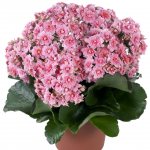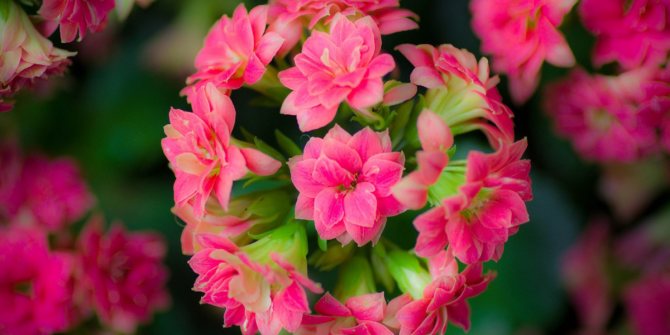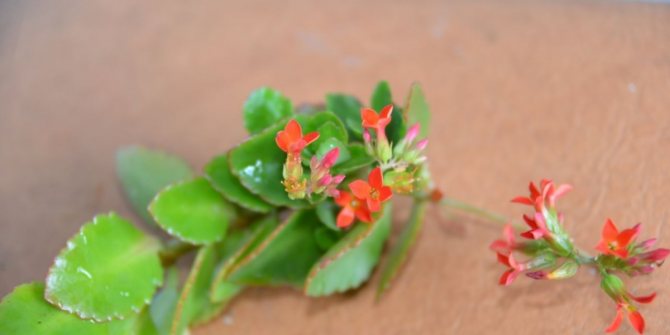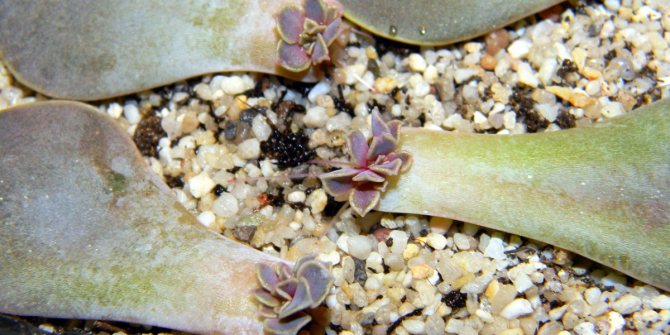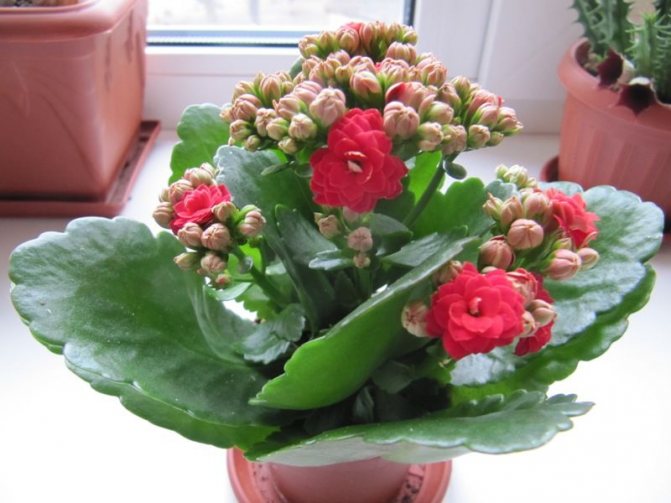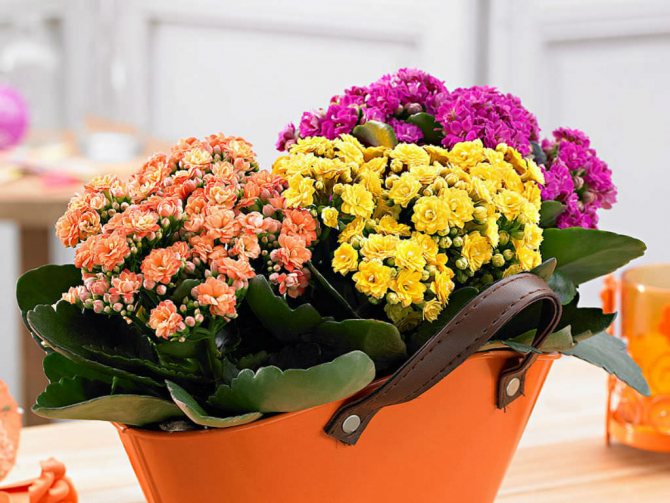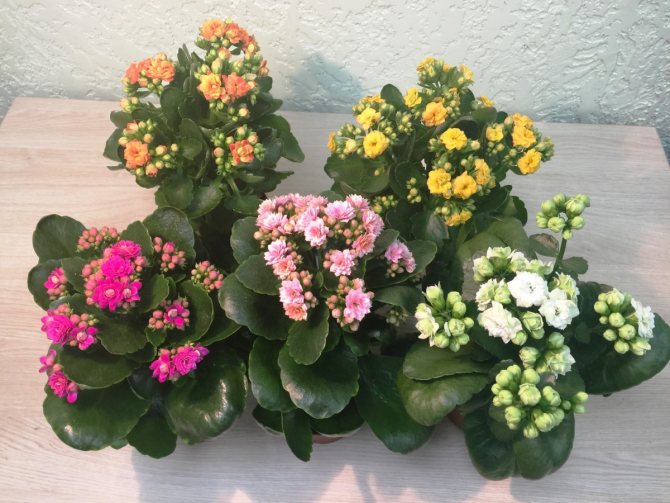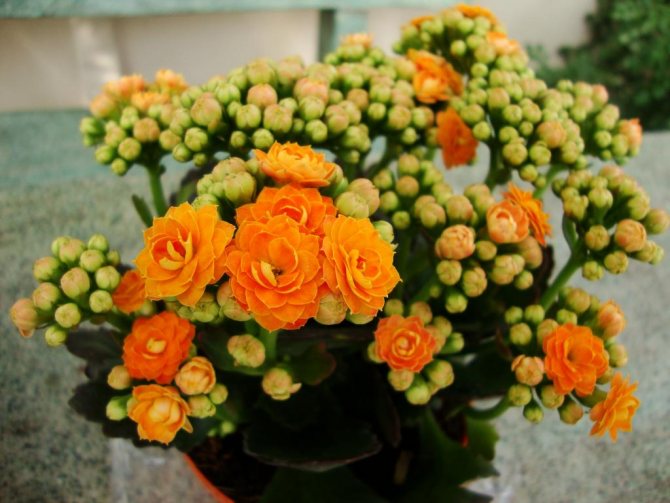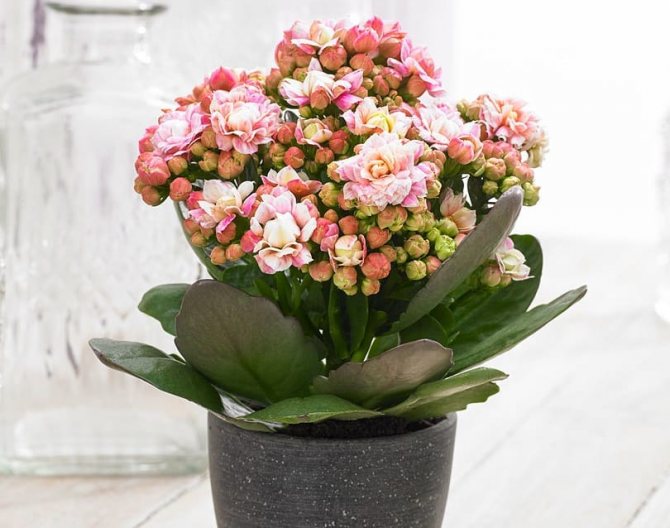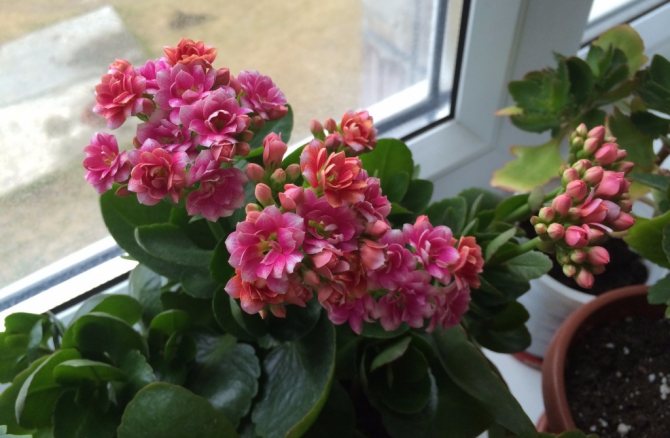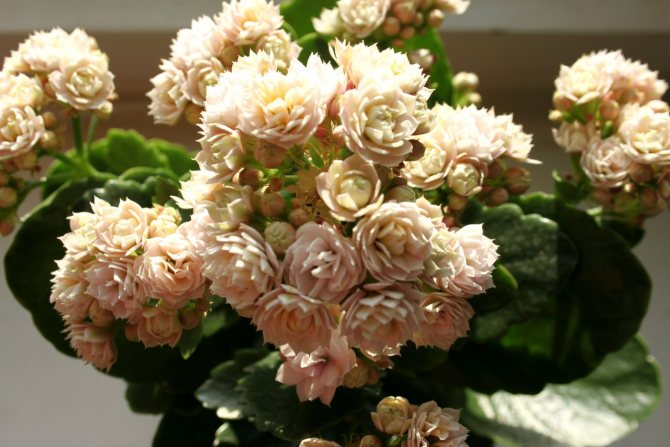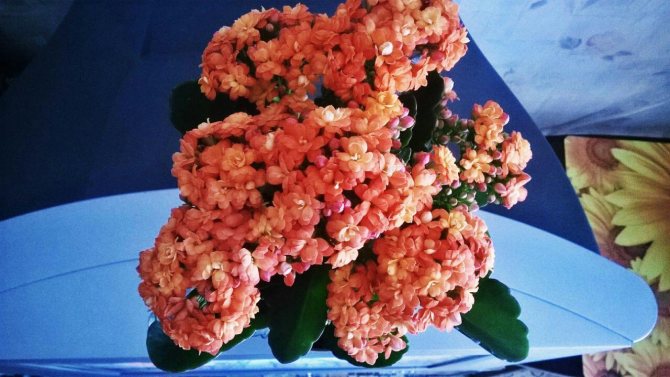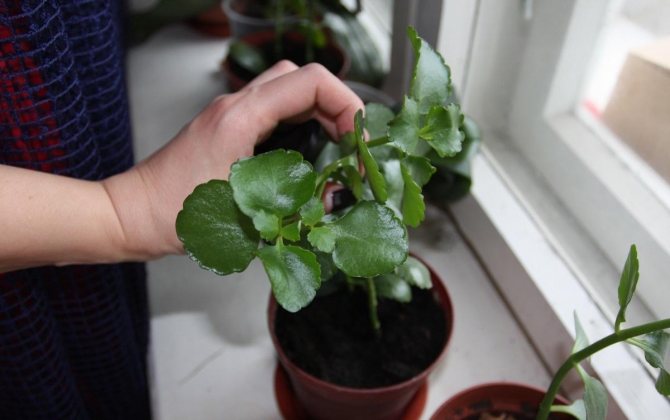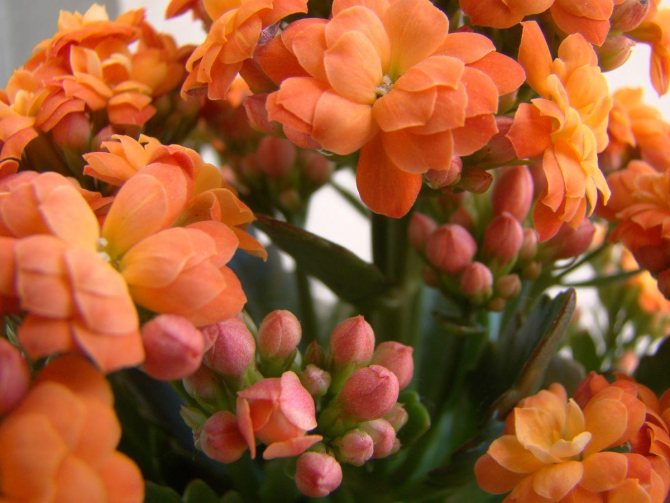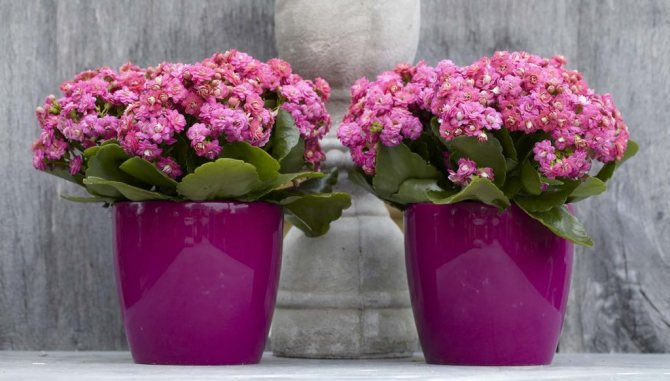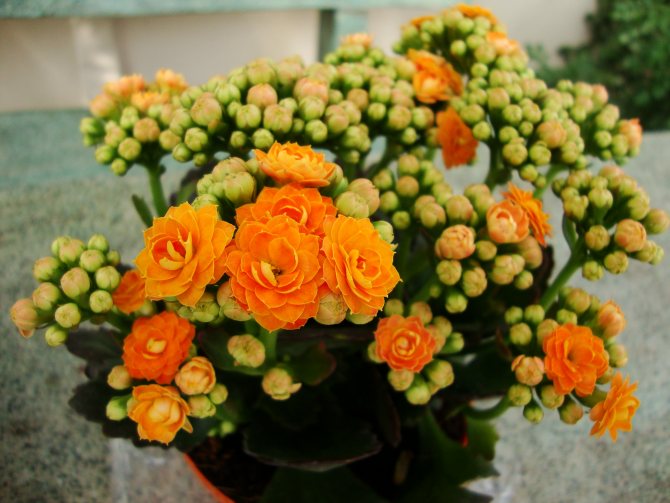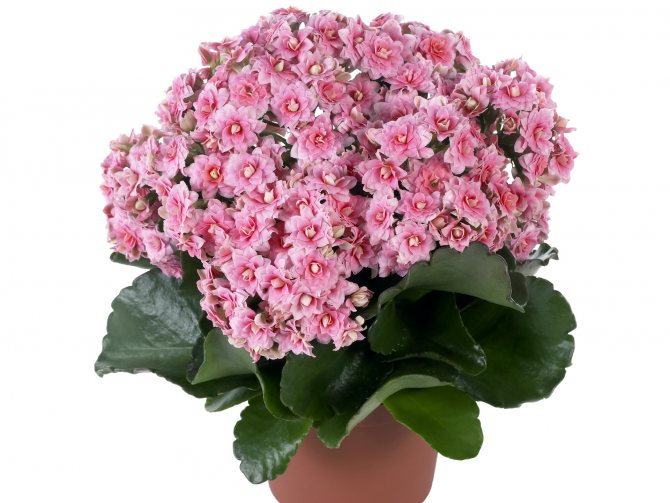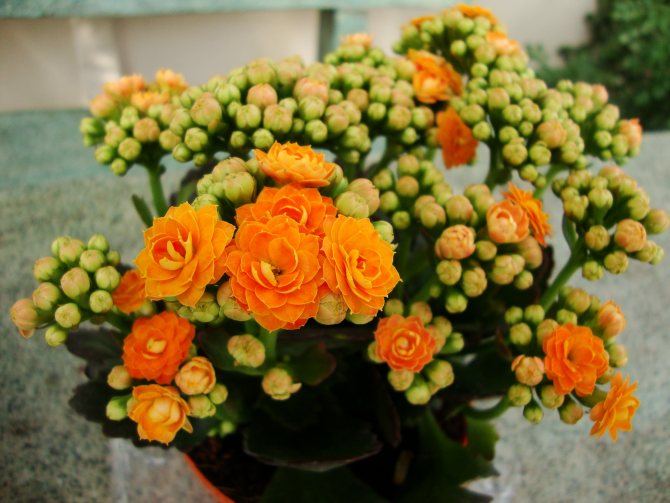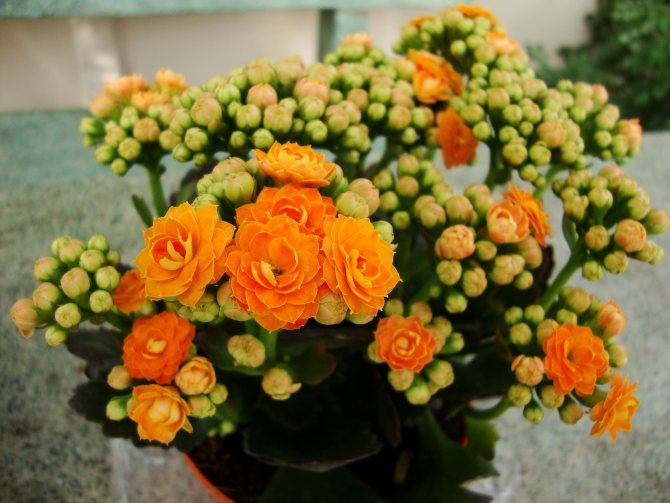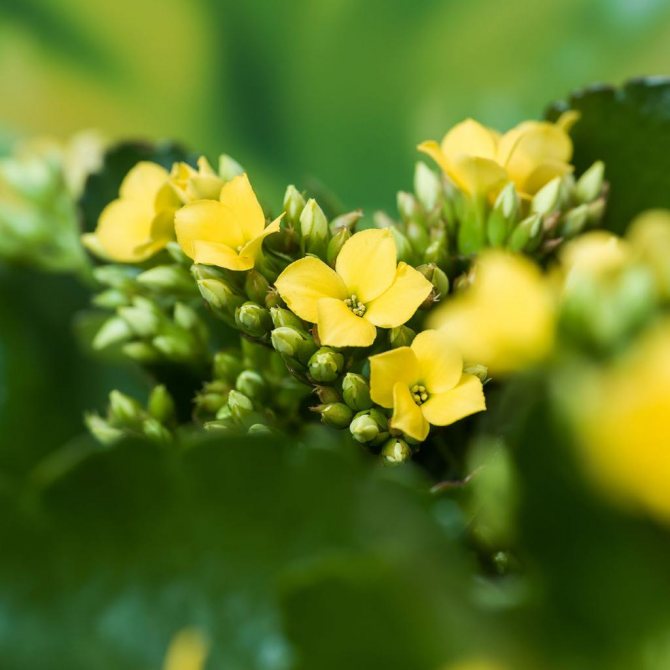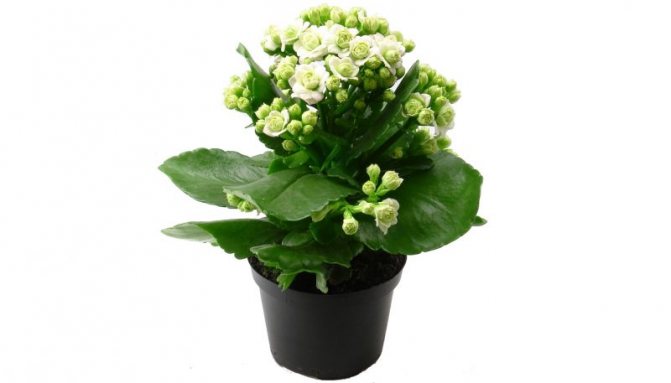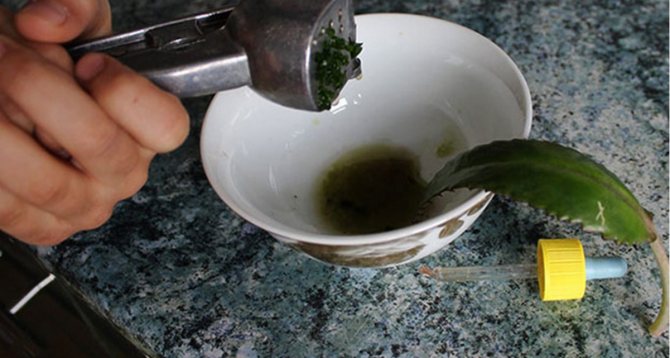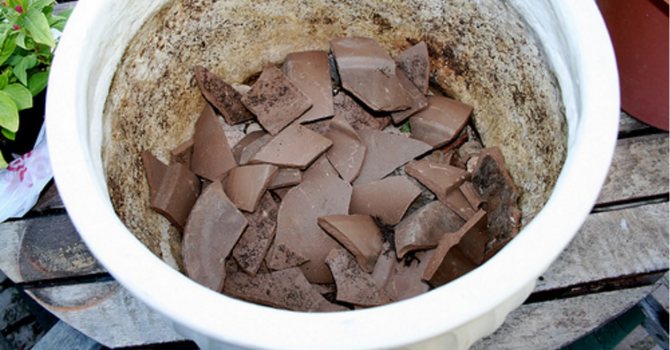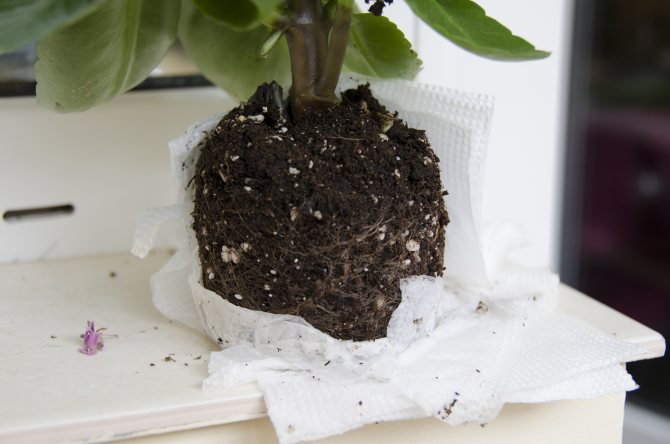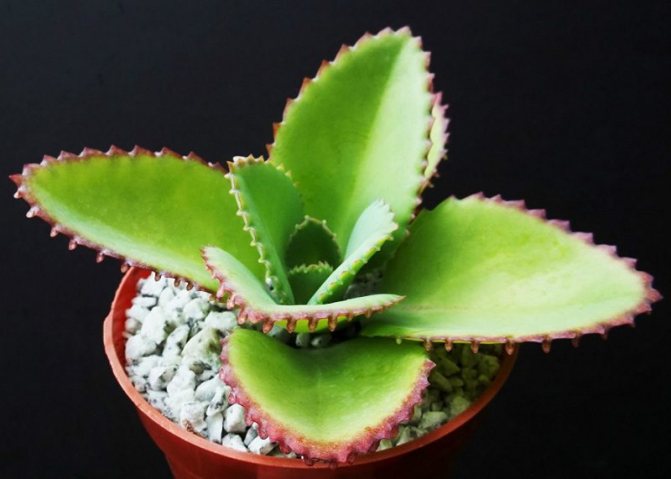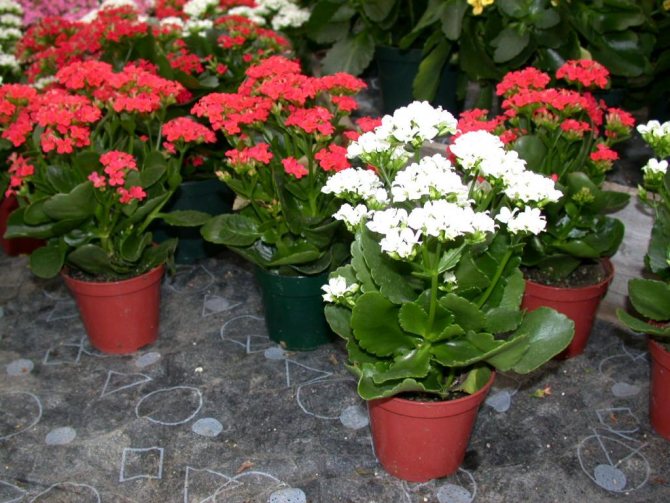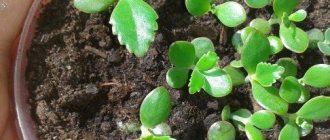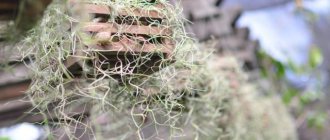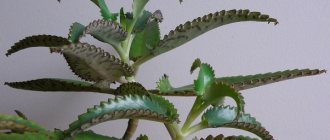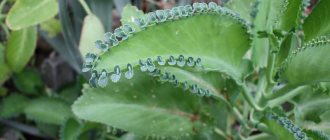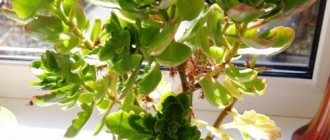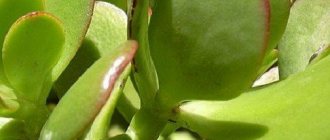Surely, you have often paid attention in stores to small pots, densely covered with small pink-like flowers. They look very impressive and enjoy a well-deserved prestige in floriculture. After all, they are not only attractive, but also unpretentious in care. Possessing miniature dimensions, they do not take up much space on the windowsill. And, at the same time, they are a bright spot among other plants due to the numerous lush and variegated inflorescences.
This is Kalanchoe Kalandiva, which is valued primarily for its attractive appearance and, to a lesser extent, for its medicinal properties.
Few people know that Kalanchoe Kalandiva is the closest relative of Kalanchoe Blossfeld. But it differs from it in more miniature size, abundance and duration of flowering.
Description of the species
This succulent grows in a tropical humid forest on humus soil. It has ovoid leaves, reaching up to seven centimeters in length and up to four in width, green, glabrous, with reddish edges. The flowers are numerous, they are collected in umbellate inflorescences and are up to one centimeter in diameter. Mostly they are red or yellow. This species was bred from Blossfeld's Kalanchoe. Bizarre ampelous and garden forms also originated from him.
Outwardly, the plant looks like a small bush, which attracts attention with its bright and at the same time delicate flowers, collected in neat "umbrellas". Despite the fact that his homeland is distant Madagascar, it grows well at home. A flower for the lazy - this is what Kalanchoe Kalandiva is often called.

Kalanchoe Kalandiva mix and mini: features and characteristics
Kalanchoe Kalandiva mini is a kind of Kalanchoe Blossfeld. Kalanchoe Mix is a succulent plant that was bred using Kalanchoe Kalandiva Mini, and in essence is its hybrid form. The homeland of the parent species is the territory of Africa, South America and Asia.
Breeding work has allowed the Mix variety to obtain some of the distinctive characteristics of the mother culture. The main difference is the significant duration of the annual flowering. The most common are pink inflorescences and white flowers.
How to care
It is easy to care for it, while flowering can delight as much as six months. Despite the unpretentiousness of this pet, despite the fact that it does not require much attention, there are still some secrets for its successful cultivation. Due to its "African roots", Kalanchoe Kalandiva is a light-loving plant. A well-lit windowsill is an excellent place to grow it. But here are the southern windows, where direct sunlight is very aggressive, it is still better to beware. Twenty degrees is considered optimal for keeping this succulent, but the flower can easily withstand lower or higher temperatures.
Photo
Transfer
Kalanchoe does not like frequent soil changes. It must be transplanted no more than once a year, only in early spring. Plants of this variety can be moved to new pots only after complete final flowering. In this case, a thorough flushing of the roots from the old soil is a prerequisite.
Another feature: Kalanchoe Kalandiva requires a transplant immediately after purchase. The reason is that the store soil is mostly peat, which is not quite suitable for this plant. As experienced flower growers advise, if for some reason it becomes necessary to transplant it during the period of abundant flowering, for example, after purchase, when you do not want to injure the plant or deprive it of its abundant cap of delicate and bright "umbrellas", you should use the transshipment method so that the pet does not was under a lot of stress.


Planting and transplanting
Young specimens (up to 3 years old) need an annual transplant, which should be carried out in early autumn. It is necessary to replant adult plants once every 4 years, excluding periods of flowering and dormancy. Before each such procedure, it is necessary to take a vessel 1 or 2 cm larger than the previous one. An ideal option for an adult Kalanchoe is a pot with a diameter of 12-18 cm. The soil for planting or replanting should be designed for succulents. You can get it at any flower shop or gardening department, etc. In addition, advanced flower growers may not buy soil at all, but prepare it themselves. This is quite easy to do, since the plant does not impose special requirements on the soil. The main conditions in this case will be the presence of acidity and good ventilation of the air. The composition of the soil should include river sand in a ratio of 4 to 1, as well as peat, leaf humus, turf soil in equal proportions. A drainage layer 1-2 cm thick must be laid on the bottom of the container.
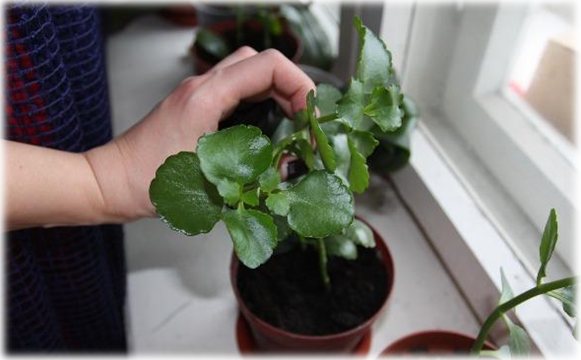

Algorithm of actions for transplanting Kalanchoe:
- Water the plant well and after 15 minutes remove it from the pot along with the earth.
- Rinse the roots to remove traces of old soil and place the flower in another container with drainage cover and fresh soil.
- Water the plant and put it in a dark place for several days, then return it back, following it as usual in the future.
- Pebbles or small chains can be poured over the soil, which will reduce moisture evaporation and the soil will be less susceptible to mold.
A newly acquired plant definitely needs a transplant, except when it is in the flowering or dormant stage.
Reproduction
You can get offspring from Kalanchoe cuttings - leafy or stem, as well as seeds or children. As a rule, even after rooting the falling and already old leaves, there is a chance to get a young plant. If in June they are planted in wet sand, covered with a glass, then roots will soon form. Children or brood buds are planted in fertile soil substrates mixed with sand.
Seed propagation can be done from January to March. In this case, there is no need to cover the sowing with earth. Seeds only need to be lightly pressed, covered with glass and shaded with paper.
The land for sowing is taken light, deciduous. The room temperature should not be lower than eighteen degrees. Crops must be aired daily, if necessary, twice, turning the glass the other side.
In this case, you need to ensure that the earth does not dry out. Water the substrate with room water. After the first shoots appear, the glass with paper is removed. After a month, the seedlings must be dived into boxes and covered with plastic wrap for a couple of days. When the plants have several leaves, they need to be transplanted into pots, the optimal size of which is seven centimeters in diameter.
Kalanchoe diseases
Almost all diseases in a plant appear as a result of a violation of conditions of detention. Let's get acquainted with the most common diseases:
- Aphid - the most dangerous disease. It is very easy to detect and can lead the plant to death.Signs of the disease: leaves turn yellow, flowers fall or do not appear. The affected foci must be cut off and burned. All that remains needs to be treated with potash or laundry soap. Make sure that the solution does not get into the soil.
- Shields. The condition of the plant deteriorates, the fungus develops, the plant does not bloom. Before removing, treat the plant with an alcohol solution, and then use a brush to remove insects. Re-wipe the affected area with an alcohol solution with any medication.
- Phytophotorous rot. Signs of the disease are brown spots at the branching points. The disease is provoked by such factors as: excessive watering, poor ventilation, excess fertilizer, very high temperature of the content. Having found a disease, you should stop watering and partially change the soil. For some time, you need to water the plant with fungicides.
- Powdery mildew. Signs of the disease: spots with white bloom on the leaves of the plant. Use regular watering and spraying with fungicides to fight the disease.
- Gray rot. Signs of the disease: weeping gray spots form on the crown of the plant. To combat the disease, it is necessary to treat the plant with fungicides, and change the conditions of the plant.
All Kalanchoe diseases are curable. It is important to detect them in time and take the necessary measures.
Pay attention to this material - Begonia: home care.
The soil
Nutrient soil mixture for Kalanchoe Kalandiva mix is made up of four parts of deciduous, two sod land, one each of compost and sand. In young rooted plants, the tip is pinched. In July, the procedure must be repeated to form a bush, which usually develops four or five shoots.
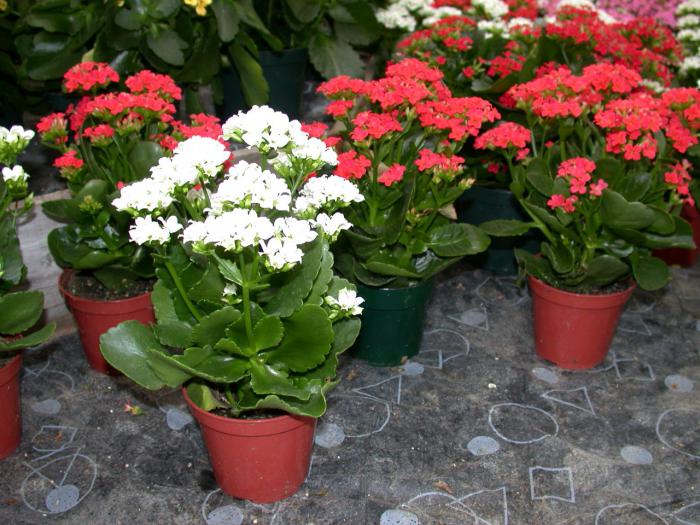

The transshipment is done in August, when the Kalanchoe Kalandiva mix, which is easy to take care of, will develop well and its roots will entwine the entire earthen lump. You can plant two plants in a pot. When transshipping, the earthen mixture is made from four parts of compost, two humus and one each of sand and deciduous soil.
Medicinal properties


Kalandiva juice is very good for colds and dermatitis. Destroys fungus, bacteria and various viruses. It is also widely used in the treatment of purulent inflammations, calluses and wet ulcers. To speed up the healing of frostbitten skin, and a mixture of juice and a fatty base will help from a burn. Kalanchoe juice is also used for erysipelas, psoriasis and varicose veins. And when taken orally, it will help with vitamin deficiency and lower cholesterol.
How to prune a plant
Many people acquire plants during their active flowering period, so they do not care about their appearance. Just like other indoor inhabitants, the descendant of Kalanchoe Blossfeld-Kalandiv also begins to lose its beautiful appearance after flowering. At this time, it is required to remove all wilted inflorescences and cut off its yellowing peduncle up to the leaves.
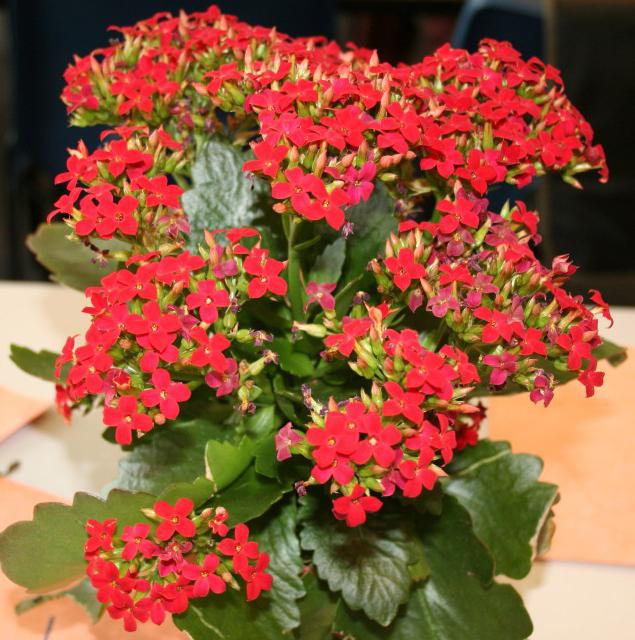

After a while, the plant will have numerous side shoots, and it itself will begin to stretch strongly, losing its compactness and beautiful shape. And to avoid this, the plant must be pruned by cutting.
All its side shoots with two leaves can be rooted in moist soil or even water. They will make excellent healthy offspring. The faded Kalanchoe needs to be formed by pinching the upper crown.
Care
Temperature
The usual room temperature in the range of 22-27 ° is quite suitable for Kalandiva.
It tolerates short-term temperature drops up to 6-9 ° and any heat, up to 40 °.
Light mode


If you want to achieve long flowering, place an African guest on a south window.
Kalandiva is very fond of light, is not afraid of direct rays of the sun.
Being on the east and west side of the house, it does not form inflorescences.
In addition, the shoots will begin to stretch and thin out, the leaves will be located far from each other, strongly exposing the stem. Kalandiva will completely lose its attractive appearance.
Watering
Like a succulent she is does not tolerate frequent watering and an abundance of water.
Constant soil moisture will provoke an attack of fungal diseasescausing root and stem rot. Drought will harm the plant much less, so do not flood the plant.
Quite enough moisten the soil every 6-8 days, even in summer. In any case, you need to wait for the soil to dry from above.
Immediately after watering, the water that has flowed out into the pan must be poured out. Experienced flower growers even recommend wiping dry both the bottom of the pot and the pallet.
Only softened water is used for irrigation. with a minimum amount of lime.


To do this, tap water must be defended or boiled, or melt and rainwater must be used. Otherwise, plaque forms on the surface of the earth, which will interfere with the passage of air to the roots.
If kept in a cool room in winter, watering is further reduced, increasing the interval between procedures by 5-7 days.
Don't worry - it won't hurt him. But excess moisture will almost certainly cause decay of the roots and base of the stems.
Humidity
Kalandiva does not need strong air humidity.
Do not spray it or place a container of water next to it. It is quite enough to occasionally wipe the leaves from dust or arrange a cool shower for the same purpose.
Dust clogs the stomata, through which the plant collects moisture and interferes with its normal development.
Top dressing
The most essential fertilizers, especially during flowering, are potassium and phosphorus. They should be applied regularly - individually or in combination.
The interval between dressings is standard - from 10 to 15 days.
And here feeding It is recommended to limit or not use organic matter at all, since it contains a lot of nitrogen.
This substance causes the flower to fatten, it begins to vigorously grow green leaves and shoots, and forgets about flowering.
In the best case, you can get a few stunted inflorescences, which will soon fall off.
The soil
Main condition - good permeability of water and air, therefore it is advisable to use loose soil, with drainage additives.
A mixture of peat, sand, humus, garden soil and perlite is perfect. You can also buy ready-made soil - universal or special for succulents and cacti.
Bloom
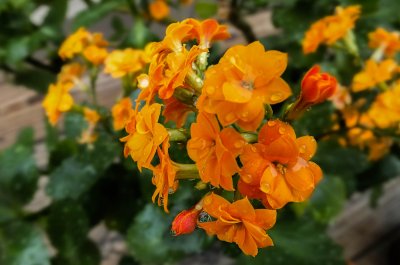

Kalandiva begins to bloom during the short daylight period - in winter.
If properly maintained, this can last 6-7 months.
Then the plant needs to rest about a month in a dark room.
Kalandiva can be removed under the table or in the closet and left alone, watering occasionally so that it does not dry out.
Pruning
This procedure is very important for Kalandiva!
Pruning rejuvenates the plant, gives it a graceful decorative shape, and helps to obtain planting material.
In addition, the operation provides lush bloom in the future, because inflorescences are formed only on young apical stems. Pruning is carried out immediately after flowering, using a well-sharpened tool.
Shoots can be cut off almost entirely, then new ones will form a nice little bush.
Transfer
Immediately after purchase, it must be transplanted into real soil - in the store the plants are kept in temporary soil that has no nutritional properties.
If a Kalanchoe blooms - it is recommended to wait for the completion of the process.
After removing from the pot, the root system is washed under running water to completely wash off the remnants of the store substrate.
Subsequent transplants do not have to be done every year, as it does not grow large.
It is quite enough to replant the plant after 2-3 years, completely replacing the soil with a new one.
Since the mix view is hybrid Kalandiva, then home care is no different.
How to make Kalanchoe Kalandiva bloom
After the first flowering, the plant will need a rest period. During this time, watering should be relatively light watering. It should be remembered that the Kalanchoe buds are laid only during the short daylight season. Of course, such conditions can be created artificially: within a month, you can place it in a place where it is possible to darken. However, the amount of sunlight should not be limited. In addition, for flowering Kalanchoe must be pinched. The last time it is done in November, after which buds appear in winter. Otherwise, in March, you need to repeat the procedure again. In this case, the pinched tops can not be thrown away, but rooted, so that new plants also turn out from them.
Reproduction of Kalanchoe
Kalanchoe reproduces at home in the following ways:
Reproduction by seeds. For this, it is better to choose the cooler months of the year. The seeds do not need to be covered with earth, you just need to cover them with glass and cloth to protect them from sunlight.
Twice a day, you need to ventilate the pot by adding water to it, so that the soil is constantly moist. All this is done within a month. Then the plant is transplanted into a pot and covered with foil for several days.
When the first leaves appear, the plant is transplanted into a pot with a diameter of about 7 cm.
Reproduction by a sheet. Before planting, the leaves of the plant should be slightly dried (1-2 days) and planted in the ground.
Care for Blossfeld's Kalanchoe, video:
Propagation by cuttings. When transplanting or in the spring, it is necessary to cut off the fresh shoots of the plant, dig it into the wet sand. After 2 weeks, a root system is formed and the plant can be safely transplanted into a pot.
Reproduction by children. The children at the ends of the leaves of the plant fall to the surface of the soil, root themselves, and then they can be planted.
Kalanchoe grows very quickly, the crown needs to be formed.
How to pinch a Kalanchoe:
- Watch the plant. If the shoots are thin, not particularly beautiful, the leaves on the upper shoots become smaller and smaller, such plants do not have enough strength to bloom. This is the main reason for pinching the plant.
- You cannot touch the flower if it has a thick crown, large and beautiful leaves. If a thin tip appears, it should be removed. The plant tolerates pinching well. Wounds usually do not form after pinching. If a wound appears, it should simply be covered with ash or charcoal.
- If the plant does not bloom for a long time, it is also advisable to pin it.
Diseases and pests
With a viral or bacterial infection, weeping brown spots appear on the Kalanchoe. In this case, the affected greens must be removed, and the plant itself must be treated with a fungicide. In this case, you need to water carefully, do not spray. Kalanchoe very rarely infect pests, but sometimes aphids appear on it, which lives on the underside of the leaves, feeding on the sap of the plant. As a result, the leaves dry out and curl up. You need to fight aphids with ready-made preparations sold in stores or with a solution of nicotine sulfate diluted in soapy water in a ratio of one gram per liter. After a day, the Kalanchoe needs to be thoroughly washed, covering the soil with plastic wrap.
Watering Kalanchoe is a simple matter even for novice florists. This representative of succulents can live in apartments and houses and is quite undemanding to the content, and with proper care, it will delight you with a beautiful and long flowering. In addition, the plant also has medicinal properties - its juice can relieve a runny nose, colds and sore throats.
The healing properties of the plant and the rules of use
In indoor floriculture, our compatriots are used to calling Kalanchoe "the tree of life" or "indoor ginseng", which is due to the medicinal properties of the vegetable juice contained in the fleshy foliage. Herbal raw materials are successfully used in gynecology and dentistry, and also have a stimulating effect on the regeneration of damaged or injured tissues.
The healing properties of Kalanchoe can be used for the prevention and treatment of the following diseases and conditions:
- cracked nipples during breastfeeding;
- tamponade in the treatment of erosive changes on the cervix;
- severe burns;
- non-healing bedsores for a long time;
- trophic ulcers of various origins;
- frostbite of varying degrees;
- chronic and acute tonsillitis;
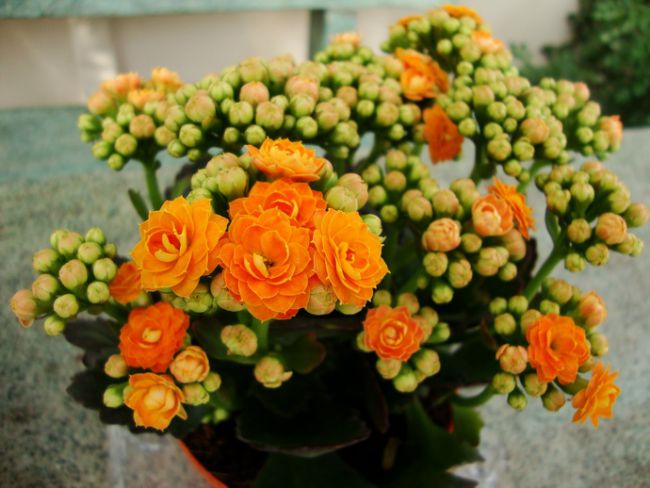

- exacerbation of stomatitis and periodontal disease;
- chronic and cold rhinitis;
- migraines and headaches;
- suffocating cough;
- stomach diseases;
- warts and acne;
- furunculosis;
- flu and colds;
- toothache.
In the presence of a cold rhinitis twice a day, you need to bury the juice of the plant, drip a couple of drops into each nostril. Acute respiratory viral diseases and influenza, accompanied by inflammatory processes in the throat, can be cured with Kalanchoe juice and water mixed in a 1: 1 ratio. With psoriasis, sore skin areas should be treated with mixtures based on 15 g of Kalanchoe juice, 45 g of eucalyptus oil and 15 g of honey, infused for three days.
Alcohol tincture can be made on the basis of Kalanchoe foliage. To prepare the tincture, you need to grind the leaves and fill them with a container of 500 ml, after which the vegetable raw materials are poured with vodka. You need to insist the raw materials for a week in a dark place, then strain. Alcohol tincture is used in the treatment of varicose veins and mastopathy, as well as abscesses and some diseases of the oral cavity.
Basic rules for watering
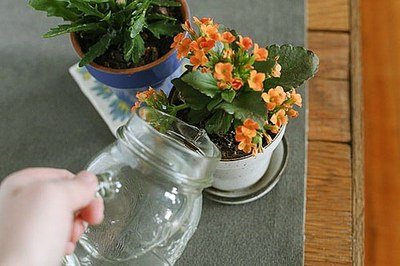

There are several rules for watering Kalanchoe at home, observing which you can guarantee the health of the plant and grow a strong bush:
- You need to use only settled or boiled water, in which a precipitate has formed - this way magnesium and calcium salts will not get into the soil;
- The water should be at room temperature - cold can provoke root rot and other plant diseases;
- While moistening the soil, make sure that moisture does not get on the trunk and other parts of the plant, as ugly spots and rot can form on the Kalanchoe;
- Keep an eye on the moderate moisture content of the soil, avoiding waterlogging and blocking, using a small amount of water for irrigation;
- Half an hour after moistening the substrate, the excess liquid remaining in the pan is drained;
- It is imperative to place a layer of expanded clay on the bottom of the pot with Kalanchoe, which performs a drainage function, removing excess moisture.
Drying falling leaves can be a sign of a lack of moisture, so in this case, it is extremely important to provide regular, but very moderate watering. Long-term absence of flowering and yellowing, decay of deciduous mass indicates an excess of liquid in the soil. An unscheduled transplant with a complete soil replacement will help to correct the situation.
Kalanchoe species
As soon as they do not call Kalanchoe - both the tree of life and the room doctor.
There is a similar article on this topic - How to care for a cactus at home? Types and photos.
The plant belongs to the Kalanchoe genus, the Tolstyankov family. The homeland of the plant is Africa. Although there are more than 100 plant species, they are united by the healing properties of the plant. Consider the most common varieties of Kalanchoe and their features:
Kalanchoe Blossfeld... Small in size, up to 30 cm, the stem is glabrous, slightly branched. Leaves up to 7 cm long, ovoid, green with shine, crenate edges with a reddish border.The flowers are medium-sized, up to 1 cm in diameter, on long peduncles, they are found in red, yellow, orange and pink shades. Flowering period March - June. It is used to treat burns, trophic ulcers, purulent infections, impotence. In 2002, a hybrid appeared - Kalanchoe Kalandiva.
Kalanchoe felt. Height 30 cm, stem erect or slightly drooping, leafy. Leaves are fleshy with coarsely toothed margins covered with brown dots or spots, oval in shape, with a blunt end, green with a thick felt coating. Blooms in July. Photo:
Kalanchoe is pinnate. Height up to 120 cm, erect stem. The leaves have a feathery arrangement. They are small, round, fleshy with obtusely serrated edges. Blooms irregularly, weakly. The flowers are full, asymmetric. It has anti-inflammatory, antibacterial, wound healing and hemostatic properties.
Kalanchoe bekharskoe. The stem is branching, glabrous. Leaves 10–20 cm long, opposite, wedge-shaped or triangular in shape, wavy, coarsely toothed, fleshy, covered with a grayish bloom. Flowers up to 7 mm long, yellow. Blooms in summer. Photo:
Kalanchoe Degremona. Height up to 50 cm, erect stem. The leaves are triangular in shape, up to 13 cm long, with serrated edges, light green in color. The leaves curl slightly at the ends. The flowers are pink or red. Used to treat periodontal disease, gastritis, dermatitis, purulent wounds, abscesses, abscesses, trophic ulcers, etc.
Kalanchoe tube-colored. The stem is light green, glabrous, juicy with green spots. Leaves with brownish-green spots, narrow-linear shape, teeth on the edges. Bell-shaped flowers, up to 2 cm long with a lilac or pink tint. Blooms in winter.
Kalanchoe marble (speckled). Height 50 cm, leaves up to 12 cm long, green with brown and purple spots, ovoid, narrowed at the base. The edges of the leaves are notched-toothed. Flowers are white. Blooms in January - April.
Kalanchoe Mangin. Height up to 30 cm, thin, hanging stems. Leaves are oval, dark green in color, opposite, fleshy, slightly wavy, juicy. The flowers are medium-sized, numerous, orange-red in color. Blooms in spring.
Kalanchoe is fiery, or fiery red. Height 30–40 cm Leaves 6–8 cm long, ovoid, narrowed at the base, serrated edges. Flowers are red-orange in color, up to 2 cm in diameter.
Kalanchoe dissected or lobed. The stem is juicy, fleshy. The leaves are serrate at the edges, fleshy, light green in color. Blooms profusely with yellow-orange colors.
How to water Kalanchoe at home for flowering
The frequency of watering Kalanchoe and the amount of water during flowering remains the same, however, a complex fertilizer containing phosphorus is used to lay bright buds. It is recommended to apply top dressing once a week.
In addition, faded Kalanchoe can be stimulated to re-lay flower buds at home. To do this, you need to carry out simple manipulations:
- Allow the plant to rest by slightly lowering the temperature of the content;
- Cut off all dried inflorescences so that they do not draw out the vitality of the plant;
- Reduce watering to 1 time in 2 weeks;
- Transfer the pot with a bush to a darkened place for 1 month, and then return it to a light windowsill;
- Increase watering - the frequency should be 2 times a week;
- During watering, use complex mineral formulations for feeding once every 2 weeks.
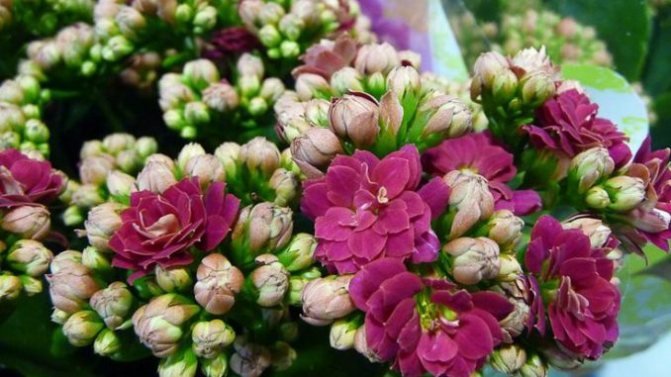

The presence of living plants in the house is a sign of the comfort of your home. These green friends are not only able to please the eye, purify the air in the room, but also have positive energy. One of the most popular plants for growing in an apartment or house is Kalanchoe Kalandiva.In this review, you will get acquainted with this houseplant, its species, methods of reproduction at home, the features of transplantation and further care.
Bloom
Many owners of this plant are surprised that after the first lush flowering of Kalandiva, the second flowering period does not occur. In such cases, the flower is usually transferred or discarded altogether. However, you should not resort to such drastic measures, because solving the problem is not difficult at all. The flowering period is directly related to the length of daylight hours. In the homeland of Kalanchoe, daylight hours are short and lasts no more than 10 hours. Thus, at home, this period should not exceed the specified time (artificial lighting is also included in it). How to be in such a situation? It's pretty simple. When evening comes (after about 9 o'clock), it is necessary to cover the windows with a thick cloth. If this is not enough, the pot with the plant should be removed to a dark place or covered with something, for example, a box. This rule must be observed until the first flower stems appear, then you can go to the usual light regime. In addition, the lack of flowering can be caused by over-feeding.


Thus, for the normal growth of Kalanchoe, three basic rules must be followed:
- do not flood the plant;
- in no case should overfeeding be allowed;
- create suitable lighting conditions.
Description of the plant
Kalanchoe Kalandiva is distinguished by its excellent decorative appearance and unpretentious care. It is referred to as succulents - plants that can accumulate a significant amount of moisture. This variety was bred artificially and cannot be seen in the wild.


Kalanchoe Blossfeld, Kalandiva variety is distinguished by lush and long flowering
The height of an adult plant does not often exceed 35 centimeters. The leaves are located at the base of the flower and are ovoid. Stems are straight and leafless.
The key feature of this species is its extremely lush and long-lasting flowering. If the conditions for the plant are favorable, then it will delight the eye with the presence of flowers throughout from 4 to 6 months a year... Forms attractive cluster-shaped inflorescences, distinguished by the richness and saturation of colors - from restrained white to bright red, yellow, purple.
Brief description of Kalanchoe Rosalina


Rosalina is a descendant of Blossfeld's Kalanchoe (like Kalandiva), brought from the island of Madagascar. Differs in compact size and long flowering exceeding 10 weeks. The color scheme of terry buds is varied and varies from pink and light orange to purple, crimson shades.
The fleshy leaves of Rosalina mix are distinguished by their ability to accumulate moisture, their shape is round or oval, and the edge itself is wavy. They are characterized by a glossy shine, which is especially evident with proper maintenance. The color of the leaves is light green and becomes even lighter on the back.
A miniature bush takes up little space on the windowsill, it reproduces well by cuttings, so it is easy to get young seedlings from one mother plant.
Home-grown species
Under home conditions, the following types of Kalanchoe Kalandiva can be successfully grown:
It is a shrub of modest size, consisting of several types of plants. Differs in a variety of colors and shades of inflorescences.
It has small dimensions, its height does not exceed 15 centimeters... It is distinguished from the previous species by its large branching and the presence of thick stems, which perfectly accumulate moisture and avoid frequent watering of the plant.
Kalanchoe Blossvelda
A semi-shrub, the height of which can be up to 45 centimeters.
Kalandiva - basic information


Kalanchoe Kalandiva is an artificially created variety, the progenitor of which is Blossfeld's Kalanchoe. Belongs to the genus of succulents of the fatty family. Warm countries such as Africa, Australia and the island of Madagascar are considered the homeland of this plant. Outwardly, it is a mini plant, 25-30 cm high, with fleshy thick leaves and a bright lush crown of inflorescences. Kalandiva is a highly decorative plant, bred specifically for decorating premises, but just like its predecessors, it has medicinal properties. It is completely unpretentious in care, which has long won the love of gardeners, and even ordinary people. The flowering period is plentiful, up to six months, from January to July. The variety of colors of Kalanchoe Kalandiva also pleases, the so-called mixes - pink, red, purple, yellow, orange, white. It is easy to hybridize, which does not make you wait for new shades every year.
Rules for the care of Kalanchoe Kalandiva
Kalanchoe Kalandiva is one of the most undemanding home flowers to care for in comparison with other plant species. Nevertheless, there are certain rules that will help keep the plant healthy and ensure its long and abundant flowering.
Choice of substrate
Although it is believed that Kalanchoe Kalandiva is not too pretentious to the type of soil, for its planting it would be more expedient to choose a special compositiondesigned for cacti or succulents. Its difference is the neutral level of acidity.
Why doesn't Kalanchoe bloom?
The plant usually blooms once a year. Each species has its own flowering period. What to do if a blooming species does not bud for a long time? In this case, it is necessary to check the plant for the presence of parasites, fungi, mold. However, there are methods to create an extra flowering period for the plant.
How to make Kalanchoe bloom? Observing the following rules, you can create the most favorable conditions for flowering Kalanchoe:
- Regular watering, care is the key to plant health.
- Provide the plant with short daylight hours. For flowering Kalanchoe, you need to be in the dark for at least 8-12 hours. Therefore, hide the flower in a closet at night, and in the morning put it back on the windowsill.
- Provide the plant with an adequate supply of fresh air. In summer, you can put the pot near an open window. Fresh air will accelerate flowering and prevent disease.
- Cut the bush short after flowering.
- Rejuvenate the plant periodically.
Flowering time: how to make the plant bloom?
If the plant is in no hurry to give flowers, then it needs help. First of all, it is necessary to remove the remnants of old peduncles and remove the upper leaves that will appear in their place. Kalanchoe transplant can also help.
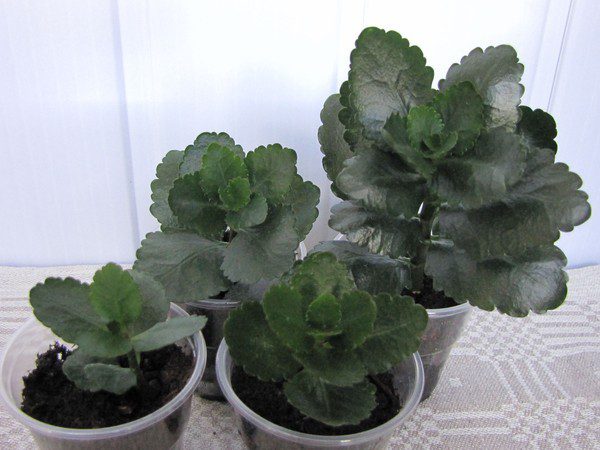

For lush flowering, it is necessary to provide the Kalanchoe Kalandiva with a dormant period with a low temperature, moderate watering and lighting.
For abundant flowering, it is necessary keep the air temperature low in winterto form ovaries, provide moderate watering and sufficient light levels.
Care after purchase
Kalanchoe Kalandiva after the move needs to adapt to new conditions. The purchased plant should be kept separate from other indoor plantings for some time. Usually 6-7 days are enough for Kalanchoe adaptation. At this time, you should make sure that the plant does not have diseases and pests. Yellowing thin leaves will tell you about their presence.
If everything is in order with the flower, it is advisable to transplant it a week after purchase. This is necessary in order to provide the plant with high-quality soil and more comfortable conditions for its growth. In the future, it will definitely not be difficult for you to give the plant the care it needs. At home, Kalanchoe Kalandiva is very easy to grow. Indeed, in fact, the chicks are quite picky and easily adapts to any situation.
Diseases and pests, the fight against them
- Fungal diseases - arise as a result of excessive soil moisture.Watering should be moderated and the plant treated with an anti-pathogen drug.
- Yellow foliage - signals a lack of light or water. It is worth establishing these indicators, as the problem is eliminated.
- Rotting defeat - manifests itself in the appearance of brown spots or sergo plaque. It is treated with special drugs.
- Powdery mildew - white bloom, which leads to the shedding of foliage. Removed with fungicides.
Prevention of most types of diseases of Kalanchoe Kalandiva is the proper care of the plant.
Pruning
Since Kalanchoe Kalandiva grows very quickly, in just 1 year it reaches 30 cm in width and height, the plant needs to be cut from time to time. To begin with, you should remove 1-2 leaves from each branch of a young plant. Then, during the period of active development, it is recommended to cut off the tops of individual shoots until a bush of a suitable shape is obtained. After the end of the flowering phase, the stems of the Kalanchoe are cut off at the base, thereby stimulating the growth of new peduncles with buds. In no case should you break off the stems and leaves of the plant. You need to cut the flower with tools prepared for this - sharp and disinfected. It can be a knife or a clerical blade. Moreover, in one such procedure, no more than 1/4 of the volume of greens can be removed.
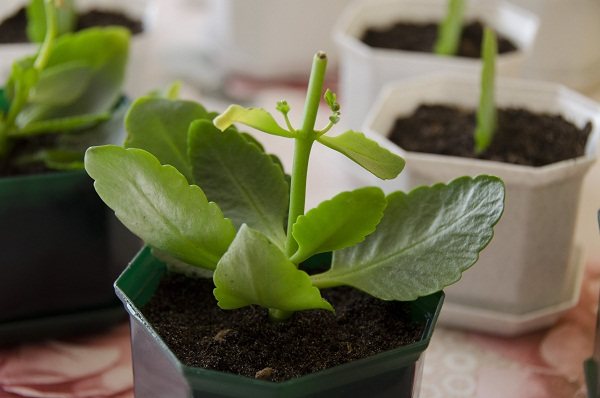

The main sign of successful plant care will be its exuberant flowering in the middle of winter. From this moment on, you can proudly admire your favorite flower.
Watering and moisture
The thick, fleshy leaves of the Kalanchoe are designed to retain moisture. So watering is not a key development factor for him. Although sometimes it is still desirable to pamper a flower with a shower. Do not forget to periodically wipe dust from its leaves.
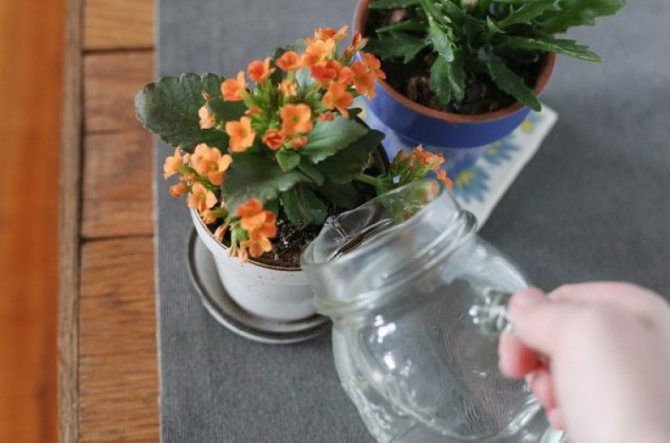

There is no need to place Kalanchoe Kalandiva near radiators - too high a temperature will negatively affect the condition of the plant. Over time, you will notice that the leaves of the flower will begin to turn yellow and fall off.
Watering the Kalanchoe needs moderate. The plant is famous for the fact that it can easily tolerate droughts, remaining without water for two whole months. Water it so that the soil only becomes slightly moist. But abundant watering will only harm the plant. Over time, its root system will rot and it will die.
But letting the flower dry out is also not worth it. This can cause the leaves to lose their natural firmness and become wrinkled. If you notice such a “symptom” in your flower, it means that it simply lacks moisture.
In winter, watering Kalanchoe should be even more scarce than in summer.
Kalanchoe mix care: humidity mode
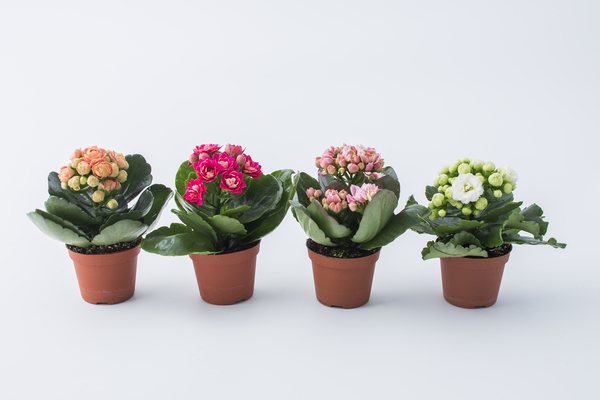

Kalanchoe needs to be watered on average once every ten to twelve days. Determine the need for watering the plant, you can by probing the soil, it must be dry. It is the root zone that needs to be watered; water should not get on the leaves and stem. It is very important to drain the water from the tray under the pot as the roots may rot.
Be careful: a large amount of moisture in the soil of the Kalanchoe can be understood by withered and drooping leaves. In this case, you need to water the plant less often.
Kalanchoe is a succulent, which means that it is already adapted to a lack of moisture. Therefore, there is no need to spray the plants and there is no need to humidify the air. But sometimes the plant can be cleaned up by removing dust and dirt from the leaves.
Flowering features
The article has already mentioned that daylight hours for Kalanchoe should last at least twelve hours. The flowering of the plant depends on this. Also note that the lighting must be bright. An interesting fact is that on a plant some flowers wither very quickly, but if you cut them off and put them in a vase, they can stand for about three weeks. When flowering stops, some of the stems must be cut off to give the plant a beautiful appearance.Cut shoots can be thrown away, but if you want as many of these plants as possible in your home, use them as cuttings.
Using the amazing properties of Kalanchoe
Modern cosmetology makes extensive use of the moisturizing properties of the plant in the manufacture of tonics, lotions and creams for the face and body. Modern medicine has also attracted Kalanchoe to its service as an excellent antimicrobial agent. The sap of the plant is used to treat various skin conditions.
Aborigines to this day use impromptu baths with Kalanchoe juice, in which sick people are placed for several hours so that their body becomes clean. Treating abrasions and cuts with plant juice gives excellent results, especially on weakened flabby skin - which is why it is advisable to have Kalanchoe on hand.
The plant contains minerals and vitamins (mainly ascorbic acid) that are good for the skin.
The bactericidal properties of Kalanchoe have been known for a long time: they rubbed their hands with the pulp of the plant before eating, smeared non-healing purulent wounds and calluses with juice, and chewed the leaves at the first symptoms of ailments. Modern pharmacology uses it in the manufacture of antimicrobial drugs.
The plant served as part of the rituals of the priests of the ancient tribes. The natives considered the Kalanchoe leaf a symbol of life-giving natural power. When a drought set in, the leaves were crushed, made into powder, and used in ritual incense. According to legends, smoking Kalanchoe caused rain on the land, emaciated by drought. The priests used drinks from the Kalanchoe to treat the sick. The leaves were also used for food. Therefore, he is incredibly popular in his homeland.
In addition to its basic properties, Kalanchoe absorbs all harmful radiation emanating from household appliances in the apartment. It is extremely useful to put a pot of Kalanchoe next to a TV screen or computer monitor.
Astrologers consider Kalanchoe to be a plant of calves and crayfish. The flower is a kind of talisman for these signs of the zodiac.
Recommendations for ensuring the correct microclimate
Kalanchoe Kalandiva is an extremely unpretentious plant. But in order to bloom next year, it needs a "rest". Therefore, the optimal conditions for periods of active vegetation and dormancy differ significantly.
Table: optimal conditions in different seasons
| Season | Lighting | Temperature | Humidity |
| Spring Summer | Bright diffused light. East or west windows. Kalanchoe has enough daylight hours with a duration of 9 hours. In cloudy weather, additional lighting with fluorescent or phytolamps is necessary. | 18-30 ° C. The range is quite wide, which once again confirms the undemandingness of the plant. | Irrelevant. It does not need additional spraying (the exception is the heat above 35оС). From time to time, it is beneficial for the plant to arrange a warm shower. This sanitary procedure is at the same time an effective preventive measure against diseases and pests. |
| Autumn winter | Light partial shade. Complete darkness is undesirable. | The temperature at which flower buds are formed for the next season is 14-16 ° C. | The usual air humidity, typical for modern apartments, is suitable. It is advisable to remove the pot away from working radiators. |
Possible growing difficulties
The unpretentiousness of Kalanchoe Kalandiva is sometimes overestimated by novice growers, and gross violations in caring for him lead to a lack of flowering, for which the flower is bred. The following reasons are likely why Kalandiva does not bloom older than two years:
- excessive moisture, It causes rotting of the roots and the general disease state of the plant, which does not have enough strength to bloom;
- incorrect lighting mode - a lack of light provokes the stretching of the stems, their thinning, in the shade, inflorescences are not formed;
- poor soil that does not provide the flower with the necessary nutrients - if, after purchase, Kalandiva was not transplanted into good soil;
- excess nitrogen in fertilizer mixtures. This is the reason for the growth of only green mass by the flower.
Correcting these errors will cause the Kalanchoe mix bush to throw out the buds (possibly already in the next season).
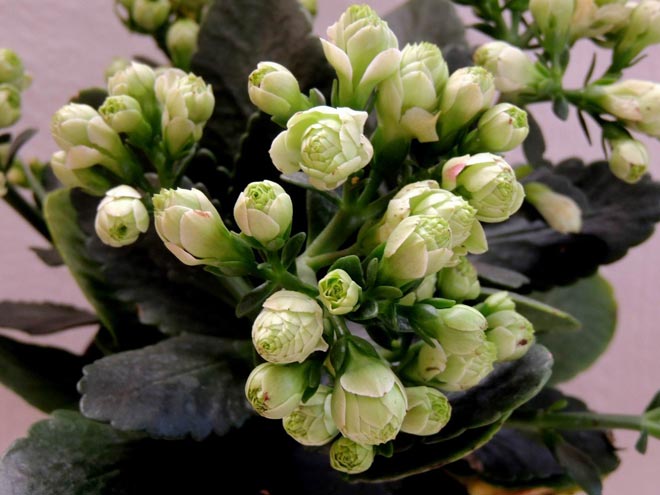

Small decorative Kalanchoe Kalandiva mix bushes take up very little space on the windowsill or desktop, but invariably delight the eye with bright colors of fresh flowers for more than six months. You just need to pay a little attention to this unassuming, but very cute plant.
Watering
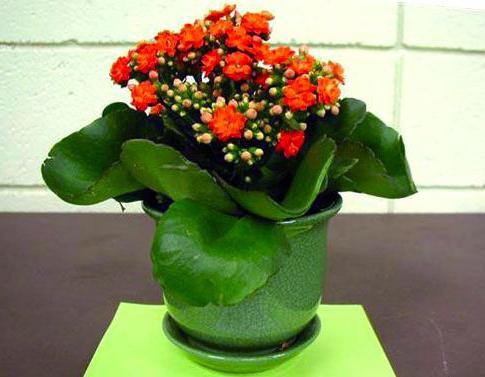

This plant needs to be moistened in small portions, watering as the topsoil dries. It is interesting that Kalanchoe Kalandiva, whose photo testifies to the fleshiness of its leaves, stores all the water in them. Therefore, to determine the need for watering, simply touch it. When a plant needs moisture, its leaves are soft, rather than elastic as in the case of saturation.
In addition, oddly enough, the flower does not need to be sprayed at all: it tolerates dry air much better. Likewise, the Kalanchoe Kalandiva mix is rather indifferent to the composition of the soil.
Possible side effects and contraindications
The active use of parts of the plant in question, internally and externally, can cause severe allergic reactions. If the patient has noticed a runny nose, swelling around the eyes, nausea, skin rashes and other similar symptoms, the use of Kalanchoe should be stopped and a doctor should be consulted. It is very important in the process of treatment to strictly follow the instructions for use, and not to arbitrarily increase the dose of natural medicine.
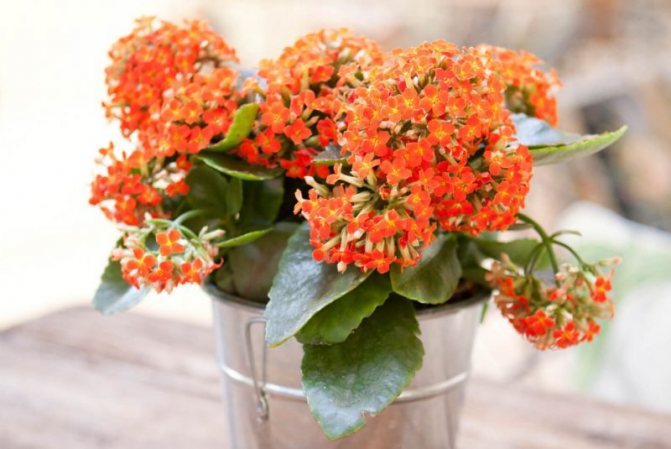

The list of contraindications for a flower also includes the following conditions:
- individual intolerance;
- pregnancy and lactation;
- children under 3 years old;
- liver disease;
- the presence of tumors;
- low blood pressure.
Table: Conditions of detention (by seasons)
| Factor | Spring Summer | Autumn winter |
| Lighting | During daylight hours, the plant should be covered with a black paper cap for 2-3 hours. | It is supposed to additionally illuminate with phytolamps for 2 hours. |
| Temperature | 20-25 ° C | 10-15 ° C |
| Air humidity | Spraying is not required. | |
Kalanchoe Kalandiva loves bright sun and short daylight hours. Therefore, the plant must be placed on one of the southern windows and the duration of the lighting must be adjusted in every possible way.
Spraying
In general, it is not necessary to spray Kalanchoe, since the plant feels quite normal without it. However, in hot summer weather, this procedure can be carried out. This will only make the plant better. The uselessness of spraying is explained by the fact that this flower has fleshy, sometimes pubescent, leaves, from which moisture evaporates rather slowly.
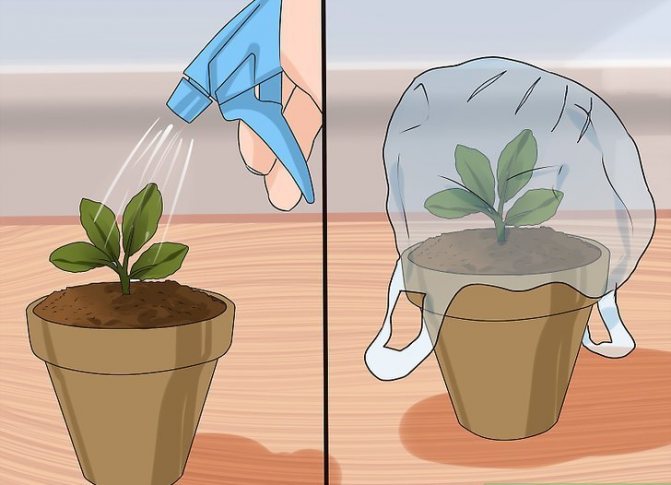

For what diseases is it used?
Various parts of the medicinal plant are not only used as an external remedy, but are also taken internally.
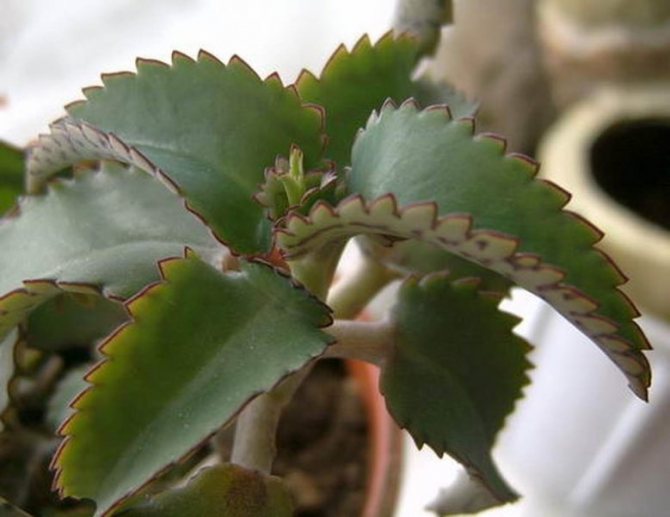

Juice, ointments, infusions and tinctures treat:
- Diseases of the skin. Including bedsores, boils, burns, purulent wounds, erysipelas.
- Diseases of the ears, eyes and mouth. The natural remedy copes well with otitis media, conjunctivitis, stomatitis and periodontal disease.
- Inflammatory diseases. Most often, the flower is used as part of the complex therapy for sinusitis, flu, ARVI.
- Arthritis and arthrosis.
- Varicose veins.
- Stomach ulcer.
- Tuberculosis.
- Serious kidney disease.
Lighting and temperature
As you already understood, the main thing for any flower is competent home care, and Kalandiva is no exception. True, she, unlike most indoor plants, is absolutely not capricious and will not take a lot of your strength from you.
The optimum temperature for Kalanchoe Kalandiva is 20-25 degrees.Although, due to its unpretentiousness, the plant will quite tolerate both the +30 ° C mark and the +12 ° C indicator. True, it will not feel very good. Although periodic temperature drops for Kalanchoe are useful, since at such moments the plant's immunity is formed. In cold weather, the flower will actively stock up on nutrients, saturating the roots and stems with them.
As for lighting, it is best to place Kalandiva on the east, west or south windowsill. True, one should beware of direct sunlight falling on the leaves of the Kalanchoe. So in summer, if necessary, it is advisable to darken the window a little. But on the north side, you should not put a plant. The lack of the necessary light will negatively affect its development. Most likely, in this case, your Kalanchoe will stop growing, the flowers will decrease, and the leaves will become faded. If you don't have any other placement option, install a fluorescent lamp next to the plant.
How to transplant
When you have prepared everything you need, you can proceed directly to the Kalanchoe transplant:
- Gently remove the flower from the old pot, after moistening the soil beforehand. It is best to turn the tub over onto the newspaper and pull it off the earthy coma.
- Remove the old soil from the roots of the Kalanchoe and carefully examine them to see if they have rotted. If you find damaged areas, cut them off.
- Now place the plant in the prepared hole so that its neck is flush with the soil.
- Water the Kalanchoe, if necessary, add more soil and gently press down on it.
That's all, now your plant can take root in a new pot.
Reproduction methods
Kalandiva reproduces well with leaves and cuttings. Moreover, the last method is considered the simplest. Cut cuttings should be slightly dried for several hours, and then put in water or a prepared substrate. Although the Kalanchoe most quickly releases roots, being in the sand. It will take about 6-7 months before the first flowering.
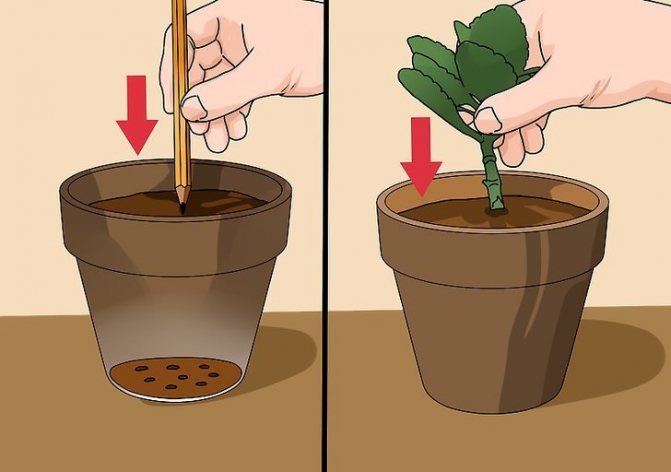

If you propagate Kalandiva with leaves, you will have to wait about a year for its flowering. Moreover, the process of dividing itself is no different from grafting.
Plant characteristic
For medicinal purposes, the aerial part of the plant is used: the stem and leaves.
More than 90% of the total mass plants are the juice.
Structure:
- organic acids;
- vitamins C and P, as well as many others;
- flavonoids;
- tannins;
- mineral salts;
- micro and macro elements;
- polysaccharides.
Medicinal (medicinal) properties of a flower.
- Cleans wounds from pathogens, slows down their growth and reproduction.
- Reduces inflammation.
- Stops bleeding.
- Cleans the affected skin from dead tissue.
- Quickly restores the upper layers of the skin after damage.
For all its merits, Kalanchoe is also slightly toxic, does not cause irritation of the mucous membranes.
What is a plant
The homeland of this amazing flower is the island of Madagascar, located in the warm tropical zone of South Africa. This plant can also be found in Asian countries. Until now, botanists cannot come to a consensus on how the Kalanchoe appeared in Russia.
The genus of tropical succulent (succulent), to which the flower belongs, is in the jumbo family. In Russia, there are "relatives" of this plant from the Tolstyanka family - stonecrop, radiola, rejuvenation - but they are accordingly more tolerant to our climatic conditions, and none of these plants can compare with Kalanchoe in their medicinal properties. There are over 100 varieties of the plant.
The flower has a thick fleshy stem and leaves of the same structure, pointed at the ends. The edge of the leaf is covered with a trail of small teardrop-shaped succulent processes. The color of a healthy plant is always a rich light green.If a stem or leaf is cut off from it, then a large amount of juice is immediately formed at the breakage site. On the windowsill, the plant does not grow higher than 35–50 cm. If the plant receives special conditions in the greenhouse, then it can grow much larger in size.
The structure of the aquiferous tissue of the Kalanchoe, which is responsible for the distribution of moisture, helps the plant to accumulate sap. Leaves and stems are covered with a thick waterproof film, which prevents moisture from evaporating and retains inside. Therefore, it is able to survive during a tropical drought.
Local tribes used the succulent shoots of the Kalanchoe to quench their thirst. By the way, some plant species have a very pleasant, slightly sour taste, and may well support the strength of tired travelers. In addition, in moments of scorching heat, people rub their skin with leaf juice so that it does not dry out.
A tropical plant loves a lot of light and warmth, so the flower pot should be placed on the south side of the room or in a well-lit place.
What problems can a florist face?
Kalanchoe, like any other plant, reacts negatively to mistakes in the care of Kalanchoe. First of all, external decorativeness suffers. The most unequivocal evidence that something does not suit him is the lack of flowering. In addition to the grower himself, the plant can be harmed by pathogenic fungi, bacteria and insects.


The yellowness of the leaves of Kalanchoe Kalandiva means a lack of light or moisture
Table: problems when growing Kalanchoe Kalandiva and ways to solve them (leaves become covered with brown spots, turn yellow, dry, etc.)
| Problem | Cause | What to do? |
| Rot (bases of leaves and shoots turn black, they are easily separated from the plant). | Too much watering. The situation is aggravated by the low temperature in the room. | Cut out all damaged parts down to healthy tissue. Treat "wounds" with crushed activated carbon. Transplant the plant by changing the soil and pot. |
| The leaves are covered with brown spots, fall off. | Lack of moisture. | Water more often. |
| Lack of nutrients. | Apply suitable fertilizer regularly. | |
| The leaves turn yellow. | Lack of light or moisture. | Increase watering, put in a more suitable place, or use additional lighting lamps. |
| Black spots form on the leaves. | Parasitic fungus (appears due to low temperatures or improper watering). | Transplant into new soil, cutting off damaged leaves. |
| Leaves lose their tone (soft when pressed), wrinkled. | Too poor watering and / or very low room humidity. | Increase watering. Raise the humidity of the air by all available means (spraying, wet pebbles in the pallet, "company" from other plants). |
| Powdery mildew (leaves are covered with a whitish coating). | Cold drafts and high humidity. | Reduce watering, protect from drafts, use fungicides (Oxyhom, Bordeaux liquid). |
| Aphids (small insects that stick around young leaves, tops of shoots and buds). | Can be brought in from the street or other indoor plants. | Isolate the plant immediately. Wash it with a solution of laundry soap, arrange a shower, use insecticides - Inta-Vir, Decis, Fas. |
Photo gallery: diseases and pests typical of a plant


If measures were not taken in time, the plant affected by root rot can only be thrown away.
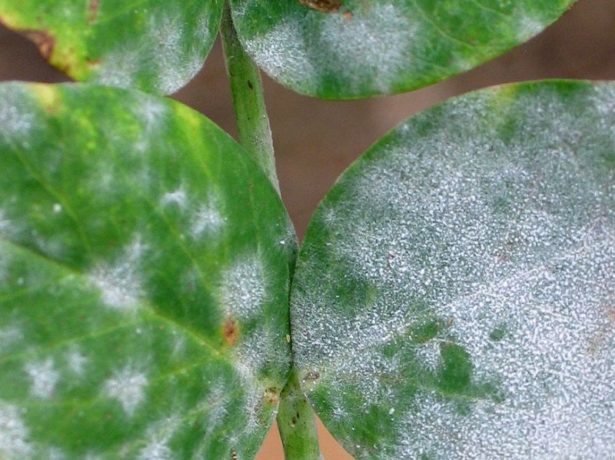

Powdery mildew develops especially quickly in high humidity and cold drafts.
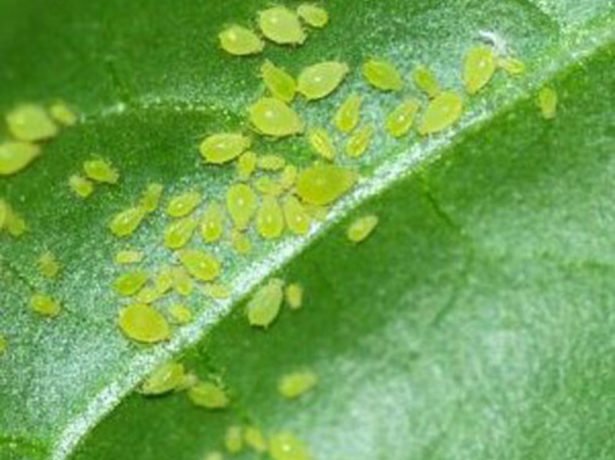

Aphids are one of the most "universal" pests of indoor plants; she will not disdain Kalanchoe
Video: possible problems when growing Kalanchoe
Temperature regime
Kalanchoe is not one of the capricious plants and feels absolutely normal at any temperature in the room. But this does not mean that you can put it on the balcony in winter.In summer, the air temperature in the room should not fall below 18 degrees and rise above +28 ° C. In winter, the flower will quite calmly endure a drop in temperature to +14 ° C. It is worth considering that if the air temperature in the room is below ten degrees with a plus sign, then there is a high probability that the plant will become very sick, and possibly even die. Also note that at low temperatures, buds begin to appear on the plant.
Transplant features
Kalanchoe does not need frequent transplants. It must be done first after purchase, and then as needed. Immediately before transplanting, you should prepare the future "place of residence" of the plant.
- The first step is to select the correct pot size. The new flowerpot should be only 2 cm larger than the previous one.
- The container must be disinfected with boiling water and a solution of potassium permanganate.
- A layer of drainage should be laid down, for example, expanded clay, clay lumps or coarse sand. The layer should be about a quarter of the height of the entire pot.
- Prepare the mixture or buy ready-made soil from the store. It is advisable to add superphosphate to the kidney at the rate of 15 grams per kilogram.
- Put the soil in a pot, and on top make a depression in it, into which you will then place the plant.
Microclimate
Temperature and lighting
The optimum temperature for a flower is 20 - 25 degrees Celsius. But since Kalanchoe is quite unpretentious, it can grow at + 30 and +12, while it will feel quite good... Such temperature drops for a flower will even be useful, since under this condition the Kalanchoe forms the immune system. For example, in cold conditions, there will be an intense accumulation of nutrients, and their outflow will be directed to the root system and stems.
Plant lighting also plays an important role. You can place a flower on the south, west, east window sill of the house window. On the south side, beware of direct sunlightso it should be shaded a little at noon. The light sides of the west and east windows are also good for flower growth and development. As for the placement of the flower on the north window, the plant will not have enough lighting. and this can affect the development of the Kalanchoe. Growth may slow down, flower size may decrease and the flowering period may be shortened sufficiently. In this case, a phytolamp with a certain wavelength of light will greatly help.
Humidity and watering
Kalanchoe is a succulent plant, which suggests that it has special fabrics for the accumulation and storage of water... In the Kalanchoe, such tissues are found in thick and fleshy leaves. Therefore, soil moisture for him is not a limiting factor. Sometimes for a flower, you can water it with a shower, or wipe the leaves, since a considerable amount of dirt and dust accumulates on the leaves.
Should not be placed near hot batteries. Hot air is devoid of essential elements, and high temperatures can damage the leaf blades. They will turn yellow and fall off.
On the underside of the leaf blades are stomata through which the plant breathes. Also, with the help of them transpiration occurs, i.e. exchange of the aquatic environment. So, if there is a high temperature, the stomata close, and the supply of oxygen and carbon dioxide stops, which greatly affects the growth and development of the flower.
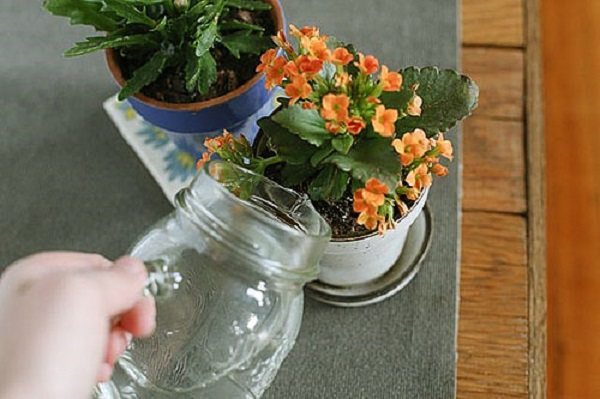

If you do not water Kalanchoe for a long time, it can last up to two months.
Watering for this flower needs moderate. Since it stores a large amount of water in the leaves, if necessary, it can give it to the necessary parts of the plant. Thus, the plant can survive drought. You need to water with a small amount of water, so that the soil is slightly moistened... If the soil is overmoistened, then its saturation with oxygen will be significantly reduced and the flow of air to the roots will stop. The plant will begin to be depressed and over time the root system can rot and everything will die in the future.
Severe drying should also be avoided, as the castings will lose their elasticity and become wrinkled and soft. This is due to the significant outflow of water and nutrients into the underground organs of the plant. In this case, you need to revise the irrigation system.
During the winter months of the year, watering should be moderate compared to the summer season.... The supply of light in winter is limited, which means that the flower does not develop much in order to preserve nutrients for flowering.
Soil and fertilizing
The substrate for Kalanchoe can be prepared by mixing parts of the earth, river sand and peat. Peat and sand will act as baking powder and creating the optimum pore size of the soil for good breathing.


Substrate for cacti and succulents
For the Kalandiva variety, in a store or garden center, you can buy a ready-made substrate that is suitable for succulents and cacti.
Like all Kalanchoe plants, Kalandiva loves periodic feeding. To do this, you need to purchase special ready-made fertilizers for cacti and succulents. These are complex fertilizers that are diluted in water and applied together with irrigation once or twice a month.
Bloom
Kalanchoe blooms periodically. Therefore, for this you need to create optimal conditions. This is moderate watering, feeding and lighting.


Kalandiva in bloom
What to do if Kalanchoe does not bloom. After he has bloomed for the first time, he needs to be allowed to rest. A prerequisite is good lighting, as well as a reduction in irrigation.... In such conditions, the flower is provoked to move nutrients to the aerial part of the plant, which ultimately will cause flowering. The inducement of the plant to bloom will also cause the obligatory pinching of the apical points of growth in the flower. If this is done around November, then it will bloom in winter.

